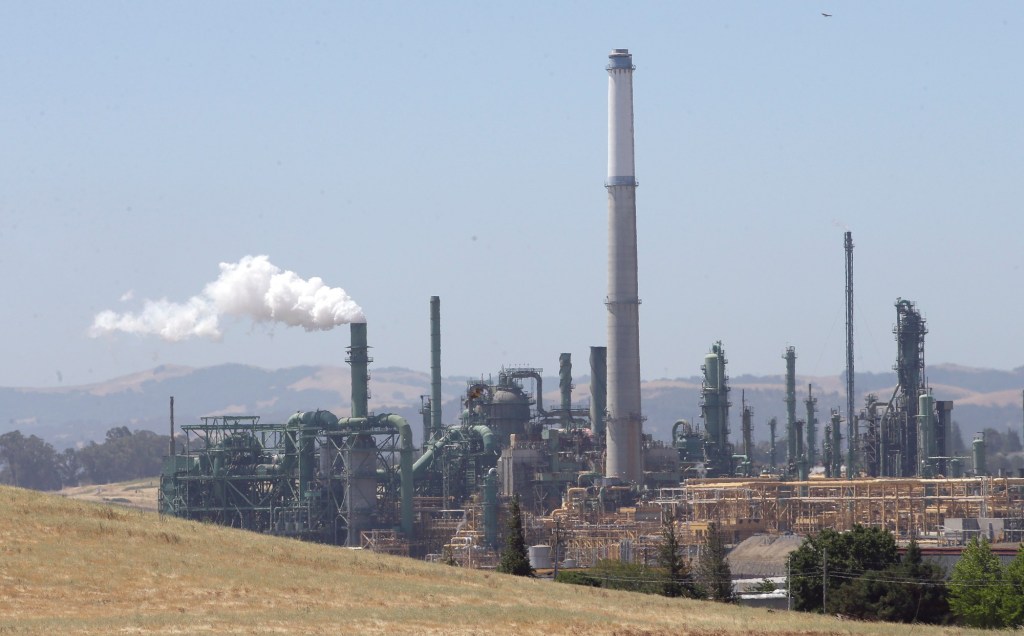San Diego gas prices have jumped 14 cents in the past five days due to a combination of factors that have tightened supplies in Southern California, fuel analysts say.
The average for a gallon of regular-grade gasoline in the San Diego area stood at $4.837 on Monday, compared to $4.696 on Oct. 29, according to AAA. The run-up included a single-day increase of nearly 8 cents on Halloween.
“It’s been kind of a bouillabaisse of bad news,” said Denton Cinquegrana, chief oil analyst at OPIS, the Oil Price Information Service that provides data and forecasting on global energy.
He pointed to the pending closure of the Phillips 66 twin refinery in the Los Angeles area, and unplanned maintenance at California refineries that included reports of flaring at a pair of facilities, as the main contributors to the jump in wholesale prices.
“It’s more than just your typical maintenance,” Cinquegrana said. “This is some unplanned stuff that’s wreaking some havoc on the market here a little bit.”
The good news? Barring additional disruptions, analysts expect prices to flatten in a few days.
“It shouldn’t get to $5” a gallon, said Patrick DeHaan, head of petroleum analysis at GasBuddy. “And then by early next week, as long as improvements are made, we may start to see prices falling a bit.”
Chevron’s refinery in Richmond reported flaring just a couple days before prices moved up and over this past weekend, and the PBF refinery in Torrance reported flaring due to planned maintenance.
Flaring at an oil refinery is a safety measure used to burn off excess gases during operations like maintenance or unexpected issues like power outages. It’s a controlled process that prevents pressure from building to dangerous levels.
Flaring can sometimes last for several days, and when it does, it can signal a temporary disruption in refinery operations — which may reduce fuel supply and lead to slightly higher prices at the pump.
“You’re seeing refinery flaring at the same time Phillips 66 says they are now basically done refining at their LA facility and that’s apparently enough to move the needle a little bit,” DeHaan said.
Phillips 66 expects to completely shutter operations at its twin refinery in Carson and Wilmington by the end of December.
Earlier this year, Valero announced it will close down its 145,000-barrel-per-day refinery in the Northern California city of Benicia. But that will not happen until April 2026, so the Valero closure is not directly impacting this current increase in prices.
The Valero and Phillips 66 facilities combine to account for about 18% of the state’s crude oil capacity, leading fuel analysts to raise concerns that the shutdowns will strain supplies of the specially blended gasoline that is sold to California drivers.
Back on Oct. 2, a big fire broke out at the Chevron refinery in El Segundo.
But gas prices in San Diego and other markets in Southern California remained stable in the immediate aftermath, Cinquegrana said, because the fire “had more of an impact on jet fuel and diesel production” at the Chevron refinery than on gasoline.
DeHaan of GasBuddy said “a lot of the impact we would have seen from such a refinery fire was mitigated by the fact that there was a lot of supply already coming to California, partially because of the shutdown at the Phillips 66 unit.”
He cited a boost in foreign imports from Japan and South Korea.
“The market is starting to adjust to this new reality that more gasoline is going to be imported (to California) to make ends meet,” DeHaan.
In light of concerns about gasoline supplies in the Golden State, Kinder Morgan and Phillips 66 recently announced plans to build the Western Gateway Pipeline that would bring fuel to western states such as Arizona and allow more oil production in California to stay within the state.
The proposal still needs to get requisite interest from potential investors and shippers, as well as clearing regulatory hurdles before work could begin.
If given the green light, the Western Gateway Pipeline project would use a combination of existing infrastructure plus new construction to establish a corridor for refined products stretching 1,300 miles from St. Louis to California.
